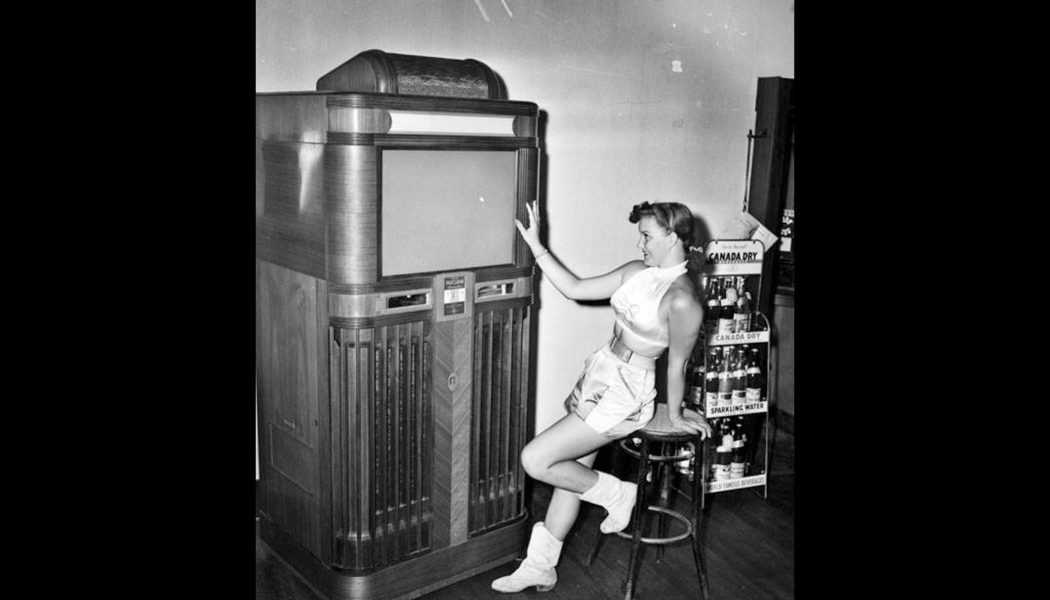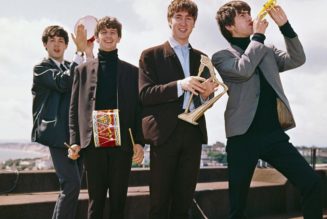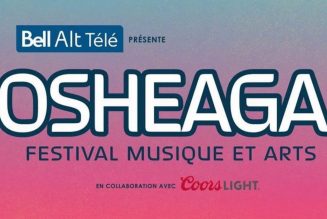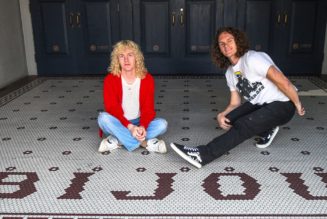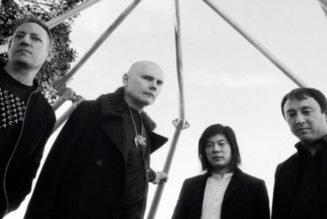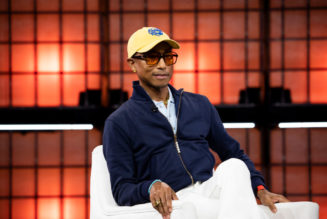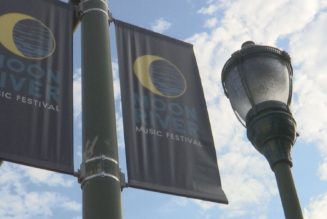On a desolate dirt road, a clutch of American soldiers chatters in front of a signpost that reads, “Chungking: 8 Miles.” Suddenly, the GIs scatter as a small military jeep comes rolling haphazardly into frame, and the three Asian American women perched in the back declaim, in jazzy close harmony: “Bum, bum, ba-ba-bum/ Call me Suzie, did the jeep jump?” They carry on their jive-filled complaints about the vehicle (at least I think they’re complaints) for a couple of verses, broken up by a private who pops out of the front seat to do an extended jitterbug.
The swinging trio, in pin-neat USO uniforms and high but flat-topped black hairdos like Russian ushanka hats, is the Kim Loo Sisters. The first Asian Americans ever to feature in a Broadway revue, the group was hyped in its heyday as “the Chinese Andrews Sisters,” though the siblings’ family back in Minneapolis was also half Polish. But they never got to cut a commercial recording due to some sour luck: a lengthy musicians union strike, for one, plus the fact that the fourth sister quit the act in 1939 to marry the son of pre-revolutionary China’s vice president.
There’s a documentary about them in the works today, but in their time, outside of Manhattan, nearly the only chance for the general public to see or hear the Kim Loos came with this 1944 clip of “Gee! The Jeep Jumps,” plus one of them singing “Take Me Out to the Ball Game,” vouchsafing their all-Americanness despite their shiny silk Asian blouses.
These three-minute wonders were part of one chapter in the long prehistory of the music video, a format that wartime audiences called Soundies—referring to some 1,880 clips of big bands, crooners, R&B combos, country acts, and others, produced specifically to play on refrigerator-size visual jukeboxes called Panorams. The units were installed in bars, bus stations, factory break rooms, military bases, and other locations across the nation between 1941 and 1947. You may have caught a few Soundies by big-name jazz musicians on YouTube, where collectors have been posting them for years. But now 10 hours’ worth of Library of Congress–restored samples have been gathered onto a new four-disc Blu-ray set from Kino Lorber called Soundies: The Ultimate Collection. While they don’t all yield backstories as juicy as the Kim Loo Sisters’, in aggregate the clips offer a pop-cultural X-ray of this pivotal decade much friskier than any history book.
In their notes to the box set, the film studies (rather than pop music) experts who are Soundies’ curators seem eager to downplay the clips’ status as precursors to the music video. These are richer social texts, they claim. It’s true that each cultural artifact should be received on its own terms, not reduced to what it “led to” nearer our lifetimes. But music videos, at every stage of development, have always served as snapshots of the zeitgeist.
Take the current debate over Jason Aldean’s country music anthem “Try That in a Small Town”—a song that came out in May and went many weeks without attracting too much attention to its racial dog whistles and overtones of vigilantism. It was when the video for the song came out, with its jumbled footage from random political protests, and especially its (accidental?) setting outside the site of a historic lynching, that the story heated up and the song climbed to No. 1 on the Billboard charts. More benignly, would Beyoncé’s Lemonade have the same stature and resonance among the records of the past decade without its corresponding, densely symbolic “visual album”?
Music fans weaned on YouTube are at least vaguely aware that the music-video story didn’t start when, 42 years ago this week, MTV launched on Aug. 1, 1981, playing the Buggles’ “Video Killed the Radio Star.” The Soundies collection is a reminder of how deep those roots go. It’s a popular truism that each new technological medium inevitably will be used to deliver porn. But the record shows that it’s also likely to be used to make music videos. When Paleolithic cave paintings were first made to “dance” in the flicker of firelight, no doubt somebody burst into song.
Starting in the 1860s, even before there were modern moving pictures, performers were using a device called the “magic lantern”—basically a pre-electricity slide projector—to display images in time with tunes. As film historian Rick Altman has written, “By the end of the century, illustrated songs were a vaudeville fixture.” As soon as movies did exist, however, people were trying to set them to music. Thomas Edison tried to synchronize films with music played on wax cylinders, without much success. But by 1902 in France, inventor Léon Gaumont had devised the Phonoscène, which could coordinate a phonograph with a film reel. Many acclaimed European singers and variety acts were recorded this way, several by pioneering female filmmaker Alice Guy-Blaché, although my favorite example is a ridiculous 1908 clip of singing German policemen.
It took until the 1920s for similar systems to be introduced to American theaters. While inventor Lee De Forest was lobbying for his Phonofilm system, he made shorts featuring vaudeville and opera performers. But the quality was not yet ready for prime time, so it was phonograph discs synced with the projector that made short musical films possible in the pre-“talkies” portion of the 1920s. Warner Bros.’ Vitaphone shorts did the most to feature musicians, but other companies had their equivalents, such as RKO’s landmark two-reeler built around Bessie Smith performing “St. Louis Blues.”
Animation made an equally crucial contribution, especially at Fleischer Studios, which as early as 1924 began producing “Song Car-Tunes,” featuring outlandish cartoon imagery set to music. These shorts’ much-imitated “follow the bouncing ball” sequences, ancestors of today’s lyric videos, helped audiences join in with the words on the screen. In later Fleischer productions, such as the Betty Boop cartoons, flowing sequences of surreal, ribald (and sometimes racist) cartoon images accompanied jazz tunes by the likes of Cab Calloway.
Other cartoon studios followed suit in the late 1920s and early 1930s, their musical-mindedness signaled by series titles like Disney’s Silly Symphonies and Warner Bros.’ Looney Tunes and Merrie Melodies (which became less tuneful and melodic after the introduction of Bugs Bunny and co.). That tendency would culminate with Fantasia, Disney’s 1940 wordless classical-music epic. But music video’s future approaches to visualizing sound may have been anticipated more keenly by abstract experimentalists such as Len Lye and Oskar Fischinger, with their colorful, geometric responses to rhythm and tone, much like the funky animated interludes future generations of kids would view on Sesame Street. All of which isn’t even to mention the evolving movie musicals of the 1930s and ’40s.
When Soundies came along, they didn’t typically aim at complex storylines or conceptual designs. Some attempted witty narratives and flirted with visual effects, but they were mostly just dressed-up performance shorts. Their innovation was more in bringing the form out of the movie theater and into the convenience and intimacy of familiar social settings. Plus, their sheer abundance created links and juxtapositions, a cultural conversation between clips, as on pop radio or on MTV four decades later. Jukeboxes for pop singles were already one of the biggest music-biz phenomena of the time, so a visual version was a natural complement, albeit trickier to engineer. Several companies vied for the market in the early 1940s, until the Mills Novelty Co. cornered it with the Panoram.
The Kino Lorber package includes many celebrated names of the period, such as Count Basie, Duke Ellington, Fats Waller, Calloway, and Hoagy Carmichael. (Not all of them come off well: The mellow drawl of Carmichael, the beloved composer of “Stardust,” features in two Soundies with racist overtones, “Lazybones” and “Hong Kong Blues.”) More numerous are early outings by postwar stars-to-be, such as Liberace, Nat King Cole, rock ’n’ roll godmother Sister Rosetta Tharpe, future rom-com icon Doris Day (singing about the prewar boom in marriages to avoid the draft in “Is It Love or Is It Conscription?”), and eventual Fantasy Island lead and Star Trek villain Ricardo Montalbán, billed only as “Ricardo,” appearing as a ferry-riding, passenger-romancing “Latin From Staten Island.” The future first Black Oscar nominee for best actress, Dorothy Dandridge, made her name partly as a dancing and singing charisma bomb in a long series of Soundies—although a couple are affronts to her renowned dignity, such as the lurid cannibals-and-coconuts swing number “A Jig in the Jungle” and one that finds her as a pinup “come to life” as a 6-inch-tall “Paper Doll.” A few titans, such as Louis Armstrong, are mysteriously missing, I assume due to rights issues.
In any case, Soundies’ strength was less in celebrity than in meeting the mood of the moment. Mills cranked out an eight-clip reel for Panoram players every week, using a range of fast-and-cheap production companies on the East and West coasts. Most acts cut their songs in a local studio and then went directly over to a film set to act out and lip-sync them (not terribly precisely), so the whole process could be finished in a couple of days. This afforded a greater immediacy than the feature film industry, and even the record business, could manage. Unlike mainstream movies, too, Soundies were generally free of censorship (though a few states tried), and played in adult-oriented environments, so they could get a bit more risqué than the prevailing standard.
The Panoram’s chief drawback compared to conventional jukeboxes was that users couldn’t select what clip to play. When you slid in your dime, it would just show whatever was next on the reel. (To hear a song twice, you’d need eight more dimes to bring it back around, the equivalent of $13 today.) So it was imperative to program a weekly variety that appealed to as broad a cross section of people as possible, from coast to coast, city to country, and North to South.
The Kino Lorber collection organizes most of its clips into thematic subsets by subject or genre, a smart and revealing approach, though it occasionally becomes a tad overly academic and self-conscious. As the results demonstrate, Soundies producers seized on trends and topicality. Once America entered the war, for example, they layered on plenty of patriotism, from a stirring musical drama about the indispensability of homefront war work, including gruesome battlefield hospital footage, to crude declarations like “We’ll Slap the Japs (Right Into the Laps of the Nazis).”
Like their vaudeville forebears, Soundies programs also delighted in novelty acts and sendups. There are several from the famous silly-song impresario and percussionist Spike Jones, whose “Clink! Clink! Another Drink” is a highlight of the Soundies drinking-song subsection, and includes Mel Blanc, the mouthpiece of Bugs Bunny and countless other cartoon staples, in a rare live-action appearance, doing one of the loopiest drunken voices you’ll ever hear. (This clip includes a Soundie-within-a-Soundie, as there’s a Panoram playing in the bar where it’s set.) But we also get to see the superb, forgotten Black comic vocal trio Day, Dawn, and Dusk, given to dressing up in female drag as one another’s romantic interests, or in the high-culture parody “Rigoletto” as a bewigged, powder-pale classical composer objecting to his music being rearranged as swing, or as an oversize mewling infant in “Sleep Kentucky Babe.”
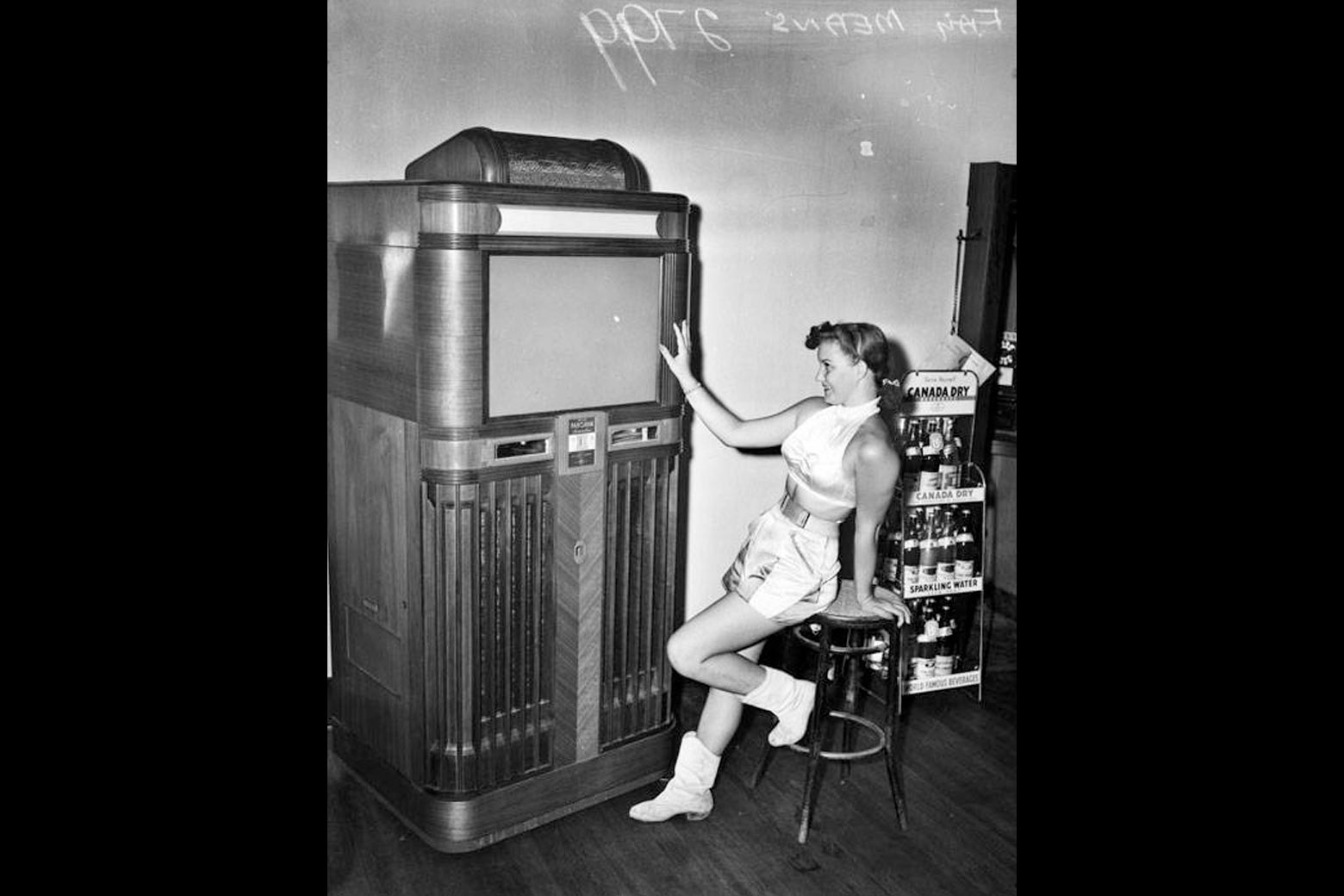

The producers played broadly to appetites for “exotic” sounds and dances such as the rumba and Hawaiian hula and every other “ethnic” novelty they could come up with, across a broad spectrum of semi-authenticity to the phoniest playacting. The results are mostly either banal global-village folklorism, semi-offensive stereotypes, or both. But there are moments of hybrid electricity, often involving a “foreign” sound being matched with hot swing syncopation. Or, for instance, when white big-band singer Gracie Barrie performs the calypso song “Stone Cold Dead in the Market.” Channeling an island protagonist, she shrugs, singing, “I kill nobody but me husband … and if I kill him, he had it comin’.” Because, of course, he was constantly beating her. As musician and critic Franklin Bruno argued in a 2011 piece about the contemporaneous Ella Fitzgerald and Louis Jordan recording of the same song, the upbeat music and adoption of Trinidadian patois served as an “ethnic mask” that in 1940s culture gave the singer a pass to address the usually forbidden subject of domestic violence.
Soundies producers were almost exclusively white men, and some of their output indulged the very worst in American pop-culture traditions inherited from minstrelsy and vaudeville. Though not included on the Kino Lorber set, a few clips featured outright blackface. (Others, which are seen here, trafficked in “hick” hillbilly caricatures, a legacy Jason Aldean’s camp has to draw on when grumbling about urban elites.) By contrast, an impressive number of Black-cast Soundies depicted a rising urban middle class, especially as centered in Harlem. As explained by the set’s lead curator, film historian Susan Delson, these clips showcased Black fashions, humor, sophistication, and influence in ways that weren’t represented in mainstream movies and other venues. While they might not have been formally in charge, the Black performers in Soundies likely had a lot of sway as collaborators to ensure that the results didn’t come off as square to Black viewers. I kept being surprised by bits of slang deployed seemingly before their time, as when June Richmond, in 1944’s “47th Street Jive,” sings, “I met a hip cat/ He called me a fly chick.”
That things-to-come feeling is most vivid in one of my favorite subsections of the Soundies collection, “Heading Toward Rock ’n’ Roll.” The eight songs here stage a mid-1940s debate over whether swing music was dead and what would follow. The boogie-woogie pianist Maurice Rocco declares, “I’m all through with this thing called swing, ooh, rock it for me!” Meanwhile, pianist Harry Gibson is revealed on 1944’s “Opus 12EEE” to have Jerry Lee Lewis’ whole-lotta-shakin’ piano act down pat nearly a decade in advance. Blond mane combed forward, he pounds the keyboard in exactly the same manner, in an oversize sport coat with his feet up on the piano bench, totally seized by sensuality. The entire sequence suggests a counter-history in which, without the conservative backlash of the postwar years, jazz transitioned directly into rock without any radical break. The whole course of youth culture could have been different.
But that conservative backlash did come, along with the end of the booming war economy, and that was basically it for the Panoram. Women left the workplace as husbands came back from overseas and moved to the suburbs. A lot of the taverns and other venues emptied out, where crowds once might have clustered round the Panoram and laughed or cut a rug. Music trends shifted away from big bands to soloists, less congenial to the raucous Soundies style. In a flash, the operation was shut down, and the Soundies story vanished down the memory hole.
Yet its sequels weren’t far behind. In the 1950s, a company called Snader Telescriptions marketed clips of popular singers to TV stations that it produced in very much the rapid-fire, cheap-sets, in-house style of the Soundies. Small-screen talk and variety shows relied on musicians for live (usually lip-synced) appearances, but acts such as the late Tony Bennett (with “Stranger in Paradise”) as well as short-lived rocker the Big Bopper (“Chantilly Lace”) tried producing pre-made clips that the shows could use instead. Online sources claim that the Bopper even used the phrase “music video” in a magazine interview in 1959, but I haven’t been able to find a copy of the original.
In the early 1960s, the promo-clip approach gained momentum. Canadian producer Manny Pittson, working on the popular show Singalong Jubilee, was influenced by the Soundies he’d seen at the shoeshine shop near his house as a kid, and started producing “mobile” clips to use on the show, with singers like Anne Murray lip-syncing on location, usually in natural settings in the Maritimes. In the United Kingdom, the makers of Top of the Pops began trying something similar.
But as usual, it was the Beatles who transformed everything. As part of their decision to quit live shows in the mid-1960s, the Fab Four started to make promo clips to send to TV in lieu of in-person appearances, for tracks such as “I Feel Fine” and “Paperback Writer.” Some of the films carried on the manic montage style they’d discovered with director Richard Lester in their features A Hard Day’s Night and Help!, which became part of the permanent vocabulary of music video. As the decade became ever more ’60s-like (and in the wake of more experimental films such as Kenneth Anger’s Scorpio Rising and his short Kustom Kar Kommandos, gay countercultural fantasias soundtracked with incongruously lush pop), the Beatles’ promo films, such as Strawberry Fields Forever, became increasingly psychedelic. The Rolling Stones, the Kinks, the Who, and many others followed suit, and by the 1970s, the likes of David Bowie and Queen were making high-concept art videos (like the one for “Bohemian Rhapsody”) that would later go into immediate heavy rotation with the birth of MTV.
Meanwhile, in an odd footnote, there was one more go-round for the idea of the video jukebox. In the age of the Panoram, Europeans had been a little preoccupied. But by the late 1950s, enterprising engineers in France and Italy, using defunct military tech and materials, took their own shot at the project. As a result, I’d guess around a thousand clips were made throughout the 1960s, some for Italy’s Cinebox and the States’ Color-Sonic, but most for France’s Scopitone. The latter’s great advances on the Panoram were that users could select specific clips, and in lucid (and sometimes lurid) color, although the apparatus remained an ungainly hulk. The finest Scopitones highlighted chanteurs/chanteuses and yé-yé artists such as Serge Gainsbourg, Françoise Hardy, and Sylvie Vartan, whose charmingly insouciant Scopitones borrowed their style from the French New Wave.
In America, woefully, the shills who licensed the Scopitone decided that it would be best suited for lounges, casinos, cocktail bars, and other dens of Mad Men–style masculine iniquity. They commissioned videos for lounge singers featuring backup dancers in costumes so skimpy that the clips often bordered on soft-core porn, while ignoring youth culture and rock music. They failed by pandering to Don Draper when the cultural momentum, and the money, was with Sally and Bobby. A couple of classics survive, such as Nancy Sinatra’s “These Boots Are Made for Walkin’ ” Color-Sonic clip, but most American Scopitones barely even merit Susan Sontag’s name-check of the genre in “Notes on Camp,” though Joi Lansing’s “The Web of Love” may earn it all by itself. In the wake of a couple of federal investigations of purported mafia connections, on top of its generally misguided management, Scopitone went kaput in the U.S. before the 1960s ended.
Still, no doubt there’d be valuable (if disheartening) historical insights to glean from a Scopitones collection as thoughtfully thematically shaped as the Kino Lorber Soundies box. And exponentially so for the music videos of the MTV era, if copyright issues weren’t a barrier. Along with everything else, the Soundies collection makes a lively case for a robust public domain and the ongoing archival exertions of the Library of Congress. Eighty years from now, when at best our own age will seem as distant and mysterious as World War II culture feels to us, will the traces of how we danced and sang and lip-synced on YouTube and TikTok be accessible, or will they be just a wasteland of unrecoverable digital fragments and defunct file formats?
A shame if so. After a week of watching Soundies, despite some appalling social attitudes, I find these mongrel litters of bygone American hucksters, naïfs, and virtuosos highly endearing. I’d wish half the same shake for our own lot, our own most ghastly viewpoints and ingenious creations, borne upon degrading currents of sound and vision, trundling into the unknown like a jolting jeep with faulty transmission.
